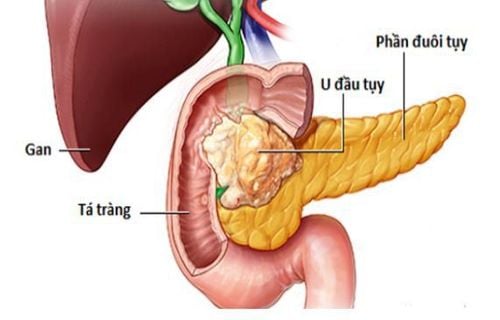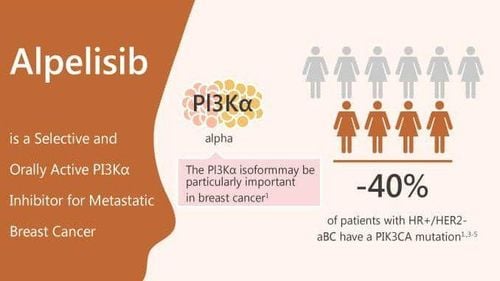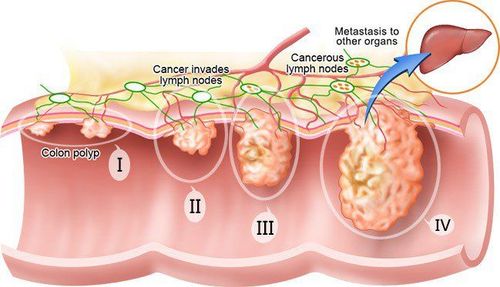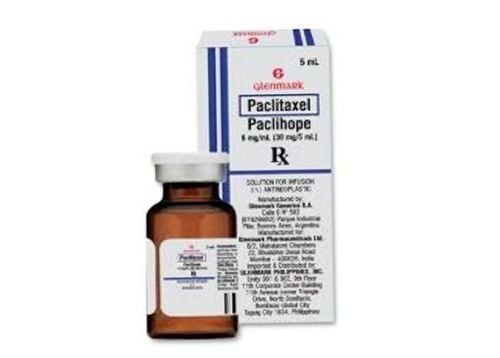This is an automatically translated article.
Post by Master, Doctor Mai Vien Phuong - Gastrointestinal Endoscopy - Department of Medical Examination & Internal Medicine - Vinmec Central Park International General Hospital.After being diagnosed with pancreatic cancer, the doctor will do diagnostic tests to determine the exact stage of the disease. Knowing the stage of the cancer is important to understanding and making decisions about treatment options and predicting a patient's outlook.
1. What is pancreatic cancer? Types of pancreatic cancer
Pancreatic cancer occurs in the tissues of the pancreas, which is an important endocrine organ located behind the stomach. The pancreas plays an essential role, producing enzymes that the body needs to digest fats, carbohydrates, and proteins.
The pancreas also produces two important hormones, namely glucagon and insulin. These hormones are responsible for controlling glucose (sugar) metabolism. Insulin helps cells metabolize glucose for energy, and glucagon, which helps raise glucose levels when they're too low.
Because of the location of the pancreas, pancreatic cancer (also called pancreatic K) can be difficult to detect and is often diagnosed at a more advanced stage of the disease. According to the American Cancer Society, pancreatic cancer accounts for about 3% of cancer diagnoses in the United States and 7% of cancer deaths.
Taxonomically, as the name implies, this type of cancer affects the pancreas, an important organ consisting of two functioning parts - the exocrine and endocrine pancreas.
The exocrine pancreas makes the enzymes needed to help you digest food, filtering it out through ducts that drain into your small intestine. Dr. Steven K. Libutti, FACS, director of the Rutgers Cancer Institute in New Jersey, says the endocrine pancreas contains cells that release important hormones into your body's bloodstream, such as insulin.
Reports often use the term "pancreatic cancer" to describe all pancreatic cancers in general. Libutti emphasizes that people should be aware of the difference between the more common pancreatic adenocarcinoma, which affects the exocrine pancreas, and pancreatic neuroendocrine cancer.
Fortunately, pancreatic neuroendocrine tumors are relatively uncommon for cancers that originate in the pancreas in general. They account for about 5-6% of pancreatic cancers. Mr. Libutti also said that neuroendocrine tumors tend to grow more slowly and originate in islet cells, which make insulin.
According to the American Cancer Society, pancreatic carcinoma accounts for about 95% of cancers in the exocrine pancreas. It usually occurs in the ducts of the pancreas but can also occur in pancreatic enzyme cells.
Dr. Mary Mulcahy, professor of hematology and oncology at Northwestern Feinberg School, said: “Neuroendocrine tumors can be very slow-growing, well-functioning, low-grade tumors, but they can grow. develop into high-grade poorly differentiated tumors.
Trắc nghiệm: Bạn biết gì về các yếu tố nguy cơ, chẩn đoán và điều trị ung thư tuyến tụy?
Ung thư tuyến tụy phổ biến thứ 10 trong những bệnh ung thư mới và là nguyên nhân thứ 4 gây tử vong do ung thư ở nam, nữ. Bài trắc nghiệm này sẽ kiểm tra kiến thức của bạn về các yếu tố nguy cơ, chẩn đoán và cách điều trị ung thư tuyến tụy.
Bài viết tham khảo nguồn: medicalnewstoday 2019
2. Causes and Symptoms of Pancreatic Cancer The cause of K pancreatic cancer is unknown. This type of cancer occurs when abnormal cells begin to grow in the pancreas and form tumors. Normally, healthy cells grow and die in moderate numbers. In the case of cancer, there is an increase in the number of abnormal cells produced and these cells eventually take over healthy cells. While doctors and researchers do not know what causes these changes in cells, but there are several common factors that increase a person's risk of developing this type of cancer. The two most significant risk factors are an inherited gene mutation and an acquired gene mutation. Genes control how cells work, so changes to those genes can lead to cancer.

In terms of symptoms, pancreatic cancer usually does not manifest until it has progressed to an advanced stage of the disease. For this reason, there are often no early signs of pancreatic cancer.
Even when cancer has developed, some of the most common symptoms can be confused with other conditions. These include:
Loss of appetite Unintentional weight loss Abdominal (stomach) or lower back pain Blood clots in the body Jaundice (yellowing of the skin and eyes) Depressed mood Metastatic pancreatic cancer can cause exacerbation of pre-existing symptoms. If the cancer has spread, you may experience additional signs and symptoms of advanced pancreatic cancer.
Survival rate is the percentage of people with the same type and stage of cancer who are still alive after a specific period of time. This number does not indicate how long people can live. Instead, it helps gauge how successful cancer treatment is.
Many survival rates are calculated as five-year percentages. It's important to note that survival is not definitive. If you have questions about these numbers, talk to your doctor.
3. Importance of staging pancreatic cancer Once you're diagnosed, your doctor will do diagnostic tests to pinpoint the exact stage of your pancreatic cancer. Knowing the stage of your cancer is important to understanding and making decisions about your treatment options and predicting your outlook.
Learn the division of activity and the terms, letters and numbers doctors use to talk about pancreatic cancer.
The staging system of pancreatic cancer is unique compared to other cancers. Mostly, cancer stages are defined on a scale of 0 to 4, with stage 4 being the most severe. Pancreatic cancer also uses the “TNM” system. This system, developed by the American Joint Committee on Cancer, helps to better explain the stage of cancer.
T classification:
The "T" category explains the size of the primary tumor and whether the tumor has grown outside the pancreas, into other nearby organs. The T classification has the following categories from TX to T4:
TX: The tumor cannot be evaluated. T0: Doctors could not find evidence of a primary tumor. T1: These tumors are quite small (about 2cm or less in diameter) and only appear in the pancreas. T2: The tumor is present only in the pancreas, but the tumor is larger than 2 cm in diameter. T3: Pancreatic cancer has spread outside the pancreas and into nearby tissues, but not into blood vessels or nerves. T4: Pancreatic cancer has spread beyond the pancreas and nearby tissues into nearby blood vessels and nerves. Classification by N:
N explains if the cancer has spread to the lymph nodes. The N classification ranges from NX to N1 as follows:
NX: Unable to assess nearby lymph nodes. N0: Cancer has not spread to nearby lymph nodes. N1: Cancer has spread to lymph nodes or distant organs. M classification:
M describes whether the cancer has spread or spread to other organs in the body. Only two types of M exist: M0 and M1.
M0: Cancer has not spread to lymph nodes or distant organs. M1: Cancer has spread beyond nearby tissues and organs into lymph nodes and distant organs.

Besides, pancreatitis is also a risk factor for pancreatic cysts. Alcohol use is a risk factor for pancreatitis. Although not everyone with pancreatitis will develop pancreatic cancer, pancreatitis is a recognized risk factor.
According to Memorial Sloan Kettering Cancer Center, most pancreatic cysts are not cancerous (benign). However, some are precancerous with the potential to develop into pancreatic cancer.
Currently, in the guidelines for nutrition and physical activity for cancer prevention, the American Cancer Society recommends:
No more than 2 cups of alcohol per day for men Women don't drink more than one cup of alcoholic beverages per day. 5. Stages of pancreatic cancer After your doctor and cancer care team determine your cancer type, they will work to stage it on a scale of 0 to 4:
Stage 0 : Cancerous tumors appear only in the top layer of pancreatic ductal cells. The cancer has not invaded the deeper layers of pancreatic tissue and it has not spread beyond the pancreas. Stage 1A: The tumor is present in the pancreas and is no more than 2 cm across. Tumors in this stage have not spread to nearby lymph nodes or tissues. Stage 1B: The tumor is present in the pancreas and is larger than 2 cm across. The tumor has not spread to nearby or distant lymph nodes. Stage 2A: The tumor has started to grow outside the pancreas but has not spread to major blood vessels or nerves. Lymph nodes remain unaffected as well as distant sites. Stage 2B: The tumor may be present only in the pancreas or it may grow outside the pancreas. However, it has not yet affected blood vessels or nerves. Cancer has also spread to nearby lymph nodes but not distant sites. Stage 3: Late-stage pancreatic cancer means the tumor is growing in locations outside the pancreas. It has grown into major nearby blood vessels and nerves. Nearby lymph nodes may or may not be affected. However, cancer does not metastasize to distant sites in the body. Stage 4: Cancer has spread beyond the pancreas and nearby sites to distant sites. 6. Treatment of pancreatic cancer Pancreatic cancer is difficult to detect. The pancreas is hidden deep in your abdomen and surrounded by many other organs. Tumors are difficult to detect through routine physical examination.
Most cases of pancreatic cancer are detected and diagnosed only after the cancer has spread to other organs. For that reason, most cases of pancreatic cancer are already in the late stages by the time they are diagnosed.
Once the doctor has determined the type and stage of the cancer, you will discuss treatment options based on the established protocol. End-stage pancreatic cancer often requires invasive treatment options. Less advanced cancers may benefit from less invasive treatment options. You and your doctor can decide what's best based on your stage, overall health, and other important factors.
Currently, early cancer screening is considered the perfect measure in the timely detection and treatment of all types of cancer. Reduce the cost of treatment and especially reduce the mortality rate in patients. Vinmec International General Hospital always deploys and introduces to customers the Early Cancer Screening Package at Vinmec - Peace of mind to live well to help with gene testing, imaging, testing of biomarkers to detect tumors you early.
Choosing the Early Cancer Screening Package at Vinmec - Peace of mind at Vinmec, customers will get:
Only one gene test can assess the risk of 16 common cancers in both men and women ( lung cancer , colorectal cancer , breast cancer , pancreatic cancer , cervical cancer , stomach cancer , prostate cancer ,.....) Early detection of early signs of cancer cancer through imaging, endoscopy, and ultrasound. The operation is simple, careful and accurate. A team of well-trained specialists, especially in oncology, are capable of handling cancer cases. With a system of facilities, advanced and modern medical equipment and a team of doctors with deep expertise and experience, it will help the examination and treatment process of patients at Vinmec become faster with High efficiency, save cost and time.
Please dial HOTLINE for more information or register for an appointment HERE. Download MyVinmec app to make appointments faster and to manage your bookings easily.
References:Can pancreatic cancer be found early?. (2015, January 9) cancer.org/cancer/pancreaticcancer/detailedguide/pancreatic-cancer-detection How is pancreatic cancer staged?. (2015, January 9) cancer.org/cancer/pancreaticcancer/detailedguide/pancreatic-cancer-staging Rochefort, M.M., Ankeny, J.S., Kadera, B.E., Donald, G.W., Isacoff, W., Wainberg, Z.A., ... Tomlinson , J.S. (2013, December). Impact of tumor grade on pancreatic cancer prognosis: validation of a novel TNMG staging system [Abstract]. Annals of Surgical Oncology, 20 (13), 4322-9 ncbi.nlm.nih.gov/pubmed/23943022 Stage information for pancreatic cancer. (2015, February 6) cancer.gov/cancertopics/pdq/treatment/pancreatic/HealthProfessional/page3 14th report on carcinogens: Alcoholic beverage consumption. (2016). ntp.niehs.nih.gov/ntp/roc/content/profiles/alcoholicbeverageconsumption.pdf Di Leo M, et al. (2017). Low alcohol and cigarette use is associated to the risk of developing pancreatitis. DOI: 10.1097/MPA.0000000000000737 Kirkegard J, et al. (2018). Acute pancreatitis and pancreatic cancer risk: A quality matched-cohort study in Denmark. DOI: 10.1053/j.gastro.2018.02.011














